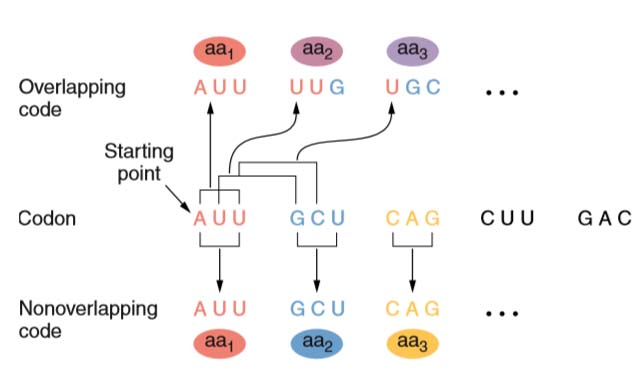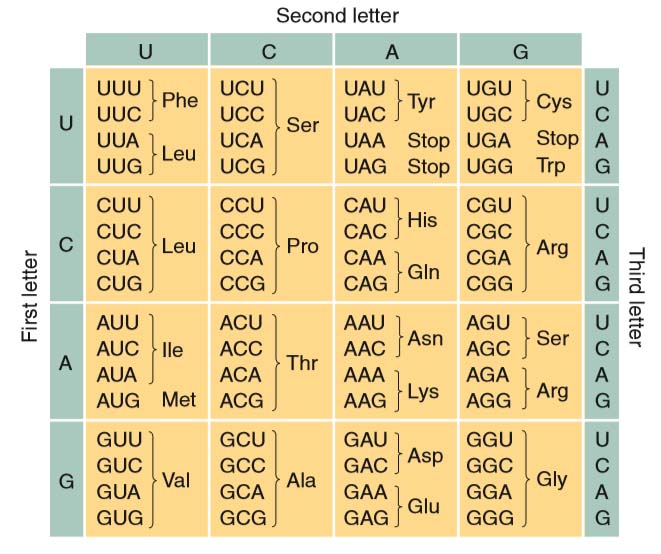If genes are segments of DNA and if a strand DNA is just a string of nucleotides, then the sequence of nucleotides must somehow dictate the sequence of amino acids in proteins.
How does the DNA sequence dictate the protein sequence?
A combination of 3 nucleotides in DNA/mRNA, which specify a particular amino acid during protein synthesis , is called genetic code . The genetic information of an organism is carried on its DNA in the base sequence and is organized as a series of genes. The DNA sequence of a gene is divided in to a series of units of three bases, i.e. Genetic codes.
CHARACTERISTICS
-
TRIPLET CODE
There are only four kinds of bases and twenty kinds of amino acids. If only one base served as a code for amino acid we could have only four codes (4)1 =4. If two bases served as a code then we would have 16 codes (4)2 = 16 . These codes were not enough for the 20 amino acids. The minimum number of bases that could be involved in amino acid selection seemed to be three . this number gave a possibility of selection of 64 amino acids (4)3 = 64. So the code for specifying amino acids does consist of 3-bases . This is called the triplet code.
Most of the amino acids are specified by more than one code . The reading occurs continuously without punctuation between the three nucleotide units .
After Cricks initial experiments , Marshall Nirenberg , Philip Leader and Har Gobind Khorana tested all the 64 codons by making artificial mRNAs and triplet codons and using them to synthesize a protein or aminoacyl-tRNA complexes in cell free systems. The full genetic code was determined during mid 1960s.
Consider the following example in which three-letter English words are used to represent the codons:
The insertion suppresses the effect of the deletion by restoring most of the sense of the sentence. By itself, however,the insertion also disrupts the sentence:

THE FAT CAT AAT ETH EBI GRA T
-
INITIATION CODON
Every gene starts with codon AUG , which normally encodes the amino acid
methionine .
-
NON-SENSE OR STOP CODONS
Out of 64 codons , three codons UAA (Ochre ) , UGA (Amber ) , and UGA (Opal) do not code for any amino acid , and hence are known as non-sense codon . These codons are usually present at the end of gene , and hence they are also called stop codons .
-
DEGENERACY
The code is degenerate which means that the same amino acid is coded by more than one codes. For example, the three amino acids arginine, alanine and leucine each have six synonymous codons.
-
NONOVERLAPPING-CODE
The genetic code is non-overlapping, i.e. the adjacent codons do not overlap. A nonoverlapping code means that the same letter is not used for two different codons. In other words, no single base can take part in the formation of more than one codon.

Figure 1 Comparison of an overlapping and a nonoverlapping genetic code. The example uses a codon with three nucleotides in the RNA (a triplet code). In an overlapping code, single nucleotides occupy positions in multiple codons. In this figure, the third nucleotide in the RNA, U, is found in three codons. In a nonoverlapping code, a protein is translated by reading nucleotides sequentially in sets of three. A nucleotide is found in only one codon. In this example, the third U in the RNA is only in the first codon.
- CODE IS COMMALESS
there is no signal to indicate the end of one codon and the beginning of the next. The genetic code is commaless (or comma-free).
Deletion of a single base in a commaless code alters the entire sequence of amino acids after the point of deletion as given below.
RNA bases: UUU CUC GUA UCC ACC
Amino acids: Phe Leu Val Ser Thr
The deletion of base C from leucine will change the genetic message in the following manner:
RNA bases: UUU UCG UAU CCA CC
Amino Acids: Phe Ser Tyr Pro —
-
CODE IS NON-AMBIGUIS
A particular codon will always code for the same amino acid. While the same amino acid can be coded by more than one codon (the code is degenerate),
the same codon shall not code for two or more different amino acids (non-ambiguous).
-
POLARITY OF CODE
The genetic code has polarity, that is, the code is always read in a fixed direction, i.e., in the 5′ → 3′ direction.
-
GENETIC CODE IS UNIVERSAL EXCEPT FOR MITOCHONDRIA
The genetic code is almost universal. The same codons are assigned to the same amino acids and to the same START and STOP signals in the vast majority of genes in animals, plants, and microorganisms. However, some exceptions have been found.
Most of these involve assigning one or two of the three STOP codons to an amino acid instead. Some exceptions have been reported for mitochondrial genome and in unicellular eukaryotes for synthesis of nonstandard proteins such as selenocysteine and pyrolysine.

Fig: 2 The genetic cod